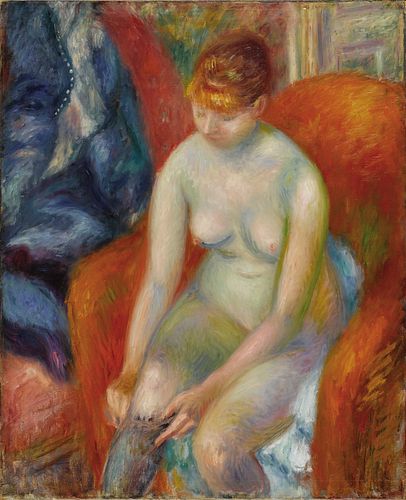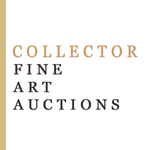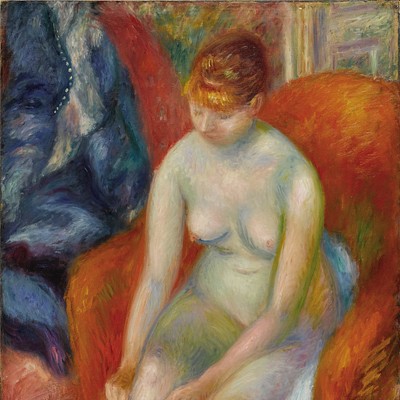William Glackens, 1870-1938
Lot 152
Estimate:
$150,000 - $250,000
Absentee vs Live bid
Two ways to bid:
- Leave a max absentee bid and the platform will bid on your behalf up to your maximum bid during the live auction.
- Bid live during the auction and your bids will be submitted real-time to the auctioneer.
Bid Increments
| Price | Bid Increment |
|---|---|
| $0 | $10 |
| $100 | $25 |
| $500 | $50 |
| $1,000 | $100 |
| $2,000 | $250 |
| $5,000 | $500 |
| $10,000 | $1,000 |
| $20,000 | $2,500 |
| $50,000 | $5,000 |
| $100,000 | $10,000 |
About Auction
By Collector Fine Art Auctions
Feb 4, 2023
Set Reminder
2023-02-04 11:30:00
2023-02-04 11:30:00
America/New_York
Bidsquare
Bidsquare : Fine European / American Paintings & Furniture
https://www.bidsquare.com/auctions/collector-fine-art-auctions/fine-european-american-paintings-furniture-12048
Collector Fine Art Auctions February 4, 2023 / 11:30 am European / American Paintings & Furniture. First Annual Sale from Tuxedo Park NY, 150 Central Park South NYC, Princeton NJ Collector Fine Art Auctions cfaauction@gmail.com
Collector Fine Art Auctions February 4, 2023 / 11:30 am European / American Paintings & Furniture. First Annual Sale from Tuxedo Park NY, 150 Central Park South NYC, Princeton NJ Collector Fine Art Auctions cfaauction@gmail.com
- Lot Description
Title: Nude, influenced by Renoir
Medium: Oil on canvas. Signed, circa 1925
Size: 32 x 26 in. (81 x 66 cm.)
Provenance: Heritage Auctions Texas May 24, 2007 [Lot 23141]
LITERATURE:
Touchstone 7 (June 1920): 193 (reproduced); List made in 1943 of works in estate of William J. Glackens left for Mrs. William J. Glackens, William Glackens File, Whitney Museum of American Art Papers, Archives of American Art, microfilm reel no. N658, frame 601, no. 47; William Glackens File, Whitney Museum of American Art Papers, Archives of American Art, microfilm reel no. 658, frame 273; Card file of works by William J. Glackens, William and Ira Glackens Papers, Archives of American Art, microfilm roll 4710, frame 376, no. 30; Richard Joel Wattenmaker, "The Art of William Glackens," Ph.D. Dissertation, New York University Institute of Fine Arts, 1973, pp. 247-248m 454, 457 (reproduced)
William Glackens was born in Philadelphia, Pennsylvania. In 1891, following his graduation from Philadelphia's Central High School where John Sloan was a fellow student, he joined the Philadelphia Record as an artist-reporter, and worked in a similar capacity from 1892 to 1895 for the Philadelphia Press. Also working for the Press at this time were Sloan, George Luks, and Everett Shinn-all of whom became associated with a group of progressive painters known as "The Eight." In 1893 Glackens studied briefly with Thomas Anschutz at the Pennsylvania Academy of the Fine Arts. Glackens and the artist Robert Henri shared a studio in 1894 and traveled to Europe together the following year. Upon his return to America in 1896 Glackens settled in New York and worked as an illustrator for the New York Herald and later for the New York World. In 1908 he became a member of the Eight (Henri, Sloan, Shinn, Luks, Maurice Prendergast, Arthur B. Davies, and Ernest Lawson) who held a landmark exhibition at the Macbeth Galleries. This exhibition marked the ascendancy of a realist style of American painting, later dubbed the "Ashcan school."
Glackens went to France in 1912 as an agent for the important Philadelphia collector of European modernist art, Dr. Albert C. Barnes, returning with works by Degas, Manet, Renoir, and Matisse, among others.
In 1913 Glackens was chairman of the committee selecting American entries in the Armory Show, and in 1917 was elected the first president of the Society of Independent Artists. The growing recognition of his paintings enabled him to accept only occasional illustrating assignments from then on. Upon his death in 1938, a memorial exhibition of his work was organized by the Whitney Museum of American Art.
Nude Pulling on Stocking is one of a radiant group of female nudes by Glackens from the 1920s. The present work is an outstanding example of this aspect of Glackens' production which was inspired a close study of nudes by Renoir in the collection of Dr. Barnes. A painting closely related to the present work was awarded the Temple Gold Medal from the Pennsylvania Academy of the Fine Arts in 1924. Glackens' nudes usually feature young models posed in interior settings, and feature some of the artist's most harmonious and complex arrangements of color and marvelous expressions of volume. Richard Joel Wattenmaker has noted that in many of his nudes, Glackens studied the 'figure in its entirety. Often [they] were portrayed in pictorial settings which included . . . draperies . . . and a background . . . of striking wallpaper floral or vegetative pattern. The nude itself was almost always . . . represented in some casual informal attitude, and frequently was partially attired in [an] undergarment' ('The Art of William Glackens' Ph.D. dissertation, New York University Institute of Fine Arts, 1973, p. 247). A small oil study for this work is recorded in the artist's inventories although its present whereabouts are unknown. (Location Unknown). - Provenance
- Shipping Info
-
Collector Fine Art Auctions requires "Third Party Shipping". We suggest requesting a quote for packing and shipping prior to bidding on an item, as you will be responsible for collection or shipping if you are the successful bidder. As a convenience to the buyer Collector Fine Art Auctions will make a referral for packing and shipping. This is at the request, expense and risk of the buyer and Collector Fine Auctions assumes no liabilities /responsibilities for the items or timing of delivery insurance for in transit items is the responsibility of the buyer Items need to be paid and picked up within 10 business days from close of Auction.
-
- Buyer's Premium



 EUR
EUR CAD
CAD AUD
AUD GBP
GBP MXN
MXN HKD
HKD CNY
CNY MYR
MYR SEK
SEK SGD
SGD CHF
CHF THB
THB













